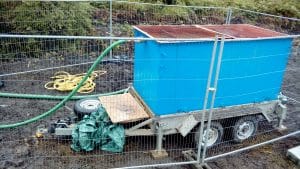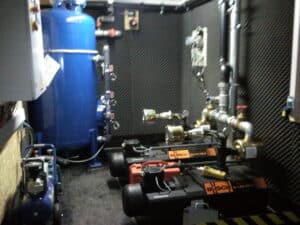Can Oil Spills be Treated?
Can oil spills be treated?

Can Oil Spills be treated?
One of the most common questions we hear on a regular basis is “can oil spills be treated”? To some extent most of them can, but there are big limitations.
Manufacturers and sales agents will tell the public about this new miracle treatment they have, but in reality it just doesn’t work like that. Here are a few of the reasons why:
• Oil and water don’t mix that well
When an oil spill penetrates the soil it makes its way into tiny capillary type pore spaces and forms a globule or vein with no water present. To get a treatment that is dissolved in water into this is near impossible. The best you can hope to achieve is some limited contact at the surface.
• It is not always easy to get the liquid treatment you are using to get to the place you want it to go
Liquids tend to follow the path of least resistance and this is rarely where you want it to be. Treatment can effctively miss the target
-
Displacement
When you strike gold and have a nice porous soil and introduce treatment liquids there is a very serious risk of displacement. Displacement is where the contamination you are trying to break down gets pushed further by the treatment. When contamination is broken down into smaller pieces it is also much more mobile and this is a major concern.
• Soil temperatures
Soil Temperatures tend to be fairly stable, but low throughout the year and particularly in the winter months. As all chemical reactions are influenced by temperature this is of importance, particularly from October to April. If the means of treatment is biological treatment will really slow for obvious reasons.
In some circumstances great results can be achieved in a sustainable and cost-effective fashion. But conditions need to be just right and you will require time, lots of time!
So, what are the ideal conditions?
• A nice porous soil that is free draining
• All soil parameters such as pH are free of extremes.
• Soil temperatures are reasonably constant and warm
• No fluctuating water table
• The soils are free from any materials that may react with treatments. The last ting we want is a by-product that hinders the process.

A mobile Oil Water Seperator used by Gaea Oil Spill Experts to treat liquids from soils
Can oil spills be treated – What types of treatment are there?
For in situ treatment, that is where the process is carried out in the ground rather than digging everything up and processing it on the surface there are some common methodologies. Below we will briefly discuss the pro’s and con’s of some common types of treatment:
Bio-Remediation as treatment of soils impacted by oil spills.
The Pro’s
Probably the most famous. Decades ago this was all the buzz and to this day we even take calls from companies trying to sell this to us. We have read books were this has worked, but in reality the conditions need to be just right. Bio-remediation should be a sustainable, cost effective eco-friendly method of addressing pollution.
The Con’s
So right that in reality we have never seen a successful job with this technology. The author is a biochemist and in almost thirty years has not had any success with this. Any improvements have been due to dilution or volatilisation. In an ideal world this is a great technology, but in reality the time taken and attention required are un-economical. Too much water, too little water, not enough heat, not enough oxygen, not enough fertilizer, too much fertilizer…..the list goes on.
Chemical Oxidation of soils following oil spills

A treatment unit equipped with vacuum extraction tecnology
The Pro’s
The technology can be performed using a fairly large range of reagents but the basic concept is the same. Injecting chemicals into the soils that decompose and release oxygen in the soil. The theory is that the oxygen then breaks down any organic contamination in the soil. In reality, oxygen in the presence of organic matter is not enough to cause the breakdown of contamination and the oxygen is in most circumstances used by indigenous micro-organisms to then break down the contaminants. This is akin to bio-remediation and is often referred to as bio-augmentation.
The Con’s
Chemical oxidation is more often used as a groundwater treatment methodology. It is definitely a feasible option, however there will be competition in the soils for the newly available oxygen. This is called a Natural Oxygen Demand (NOD) and it can be very substantial, sometimes being much higher than the amount required to completely degrade the contaminant. This needs to be factored into any feasibility study. There are also the obvious issues mentioned at the beginning of this article regarding mixing and displacement.
Capping of oil spill impacted soils
Capping is a simple process where when you are in the exact situation where you know for certain that the contaminated material will not migrate downwards or outwards. The only possible way it can interact with receptors is from the surface. In this instance barriers such as membranes or a physical distance between humans or structures can be created by placing a minimum distance of clean soil (say 1 meter) between the contamination and for instance a child that may play in a garden. In this instance the material is still present, but it can be demonstrated that it is not a risk and it is perfectly fine for it to remain where it is.
Thermal Treatment of soils impacted by oil spills
Simple. Heat is introduced into the soils to volatilise any low boiling point contaminants such as oils or solvents. In theory this is a great technology, however there are some pitfalls.
Not all fractions of oil have low boiling points, resulting in some being removed, others not budging and more commonly others boiling off but then condensing again very near by. The key to this technology working is an extremely effective extraction apparatus. More effort needs to be put in to removing vapour than the heating part to ensure the best chance. At the same time, some major contractors / consultants have ended up in trouble with this technology.
Electrokinetic
This methodology essentially uses electricity to create electrical fields in a body of soil between a positive & negative electrodes. The charge then works on the soil to create movement of injected reagents and also some movement of electrically charged contaminants. As oils are not charged they are not effected, but can be collected as they accumulate together due to their aversion to the surrounding charge.
There are issues surrounding the amount of electricity required and the fact it is direct current which usually means the use of generators.
Dig & Dump
It is what it says! In some instances the most cost-effective method is to physically remove the material and place it in a landfill site where it can be managed forever. We really don’t like this as it means a very valuable and non-renewable resource is lost forever.
Conclusion
Can Oil Spills be Treated? Well, yes but to a limited extent. If money is no object and neither is time this is the way to go. If time and money are somewhat important but not the full motivation we would say use a combination of techniques to achieve the best results in terms of time and cost effectiveness.